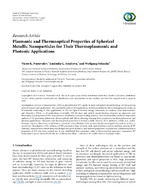Plasmonic and Thermooptical Properties of Spherical Metallic Nanoparticles for Their Thermoplasmonic and Photonic Applications

Date
2014Publisher
Bibliographic entry
Pustovalov, V. K. Plasmonic and Thermooptical Properties of Spherical Metallic Nanoparticles for Their Thermoplasmonic and Photonic Applications / V. K. Pustovalov, L. G. Astafyeva, W. Fritzsche // Journal of Nanoparticles. – 2014. – Vol. 2014. – P. 1-15.
Abstract
Investigations and use of nanoparticles (NPs) as photothermal (PT) agents in laser and optical nanotechnology are fast growing areas of research and applications. The potential benefits of NPs applications include possibility for thermal imaging and treatment of materials containing of NPs, applications of NPs for light-to-thermal energy conversion, in catalysis, laser nanomedicine, and chemistry. Efficiency of applications of metallic NPs for laser and optical nanotechnology depends on plasmonic and thermophysical properties of NPs, characteristics of radiation, and surroundingmedium. Herewe present the results of comparative analysis of NP properties (plasmonic, thermooptical, and others) allowing selecting their parameters for thermoplasmonic and photonic applications. Plasmonic and thermooptical properties of several metallic (aurum, silver, platinum, cobalt, zinc, nickel, titanium, cuprum, aluminum, molybdenum, vanadium, and palladium) NPs are theoretically investigated and analysis of them is carried out. Investigation of the influence of NPs parameters (type of metal, radii, optical indexes, density, and heat capacity of NP material), characteristics of radiation (wavelength and pulse duration), and ambient parameters on plasmonic and thermophysical properties of NPs has been carried out. It was established that maximum value of thermooptical parameter (maximum NP temperature) can be achieved with the use of absorption efficiency factor of NP smaller than its maximum valu.
